When the motorcycle press announced that MotoAmerica was going to have an exhibition race for performance baggers, most race fans had to check the calendar to make sure it wasn’t April Fool’s Day. Surprisingly, it not only turned out to be true, but it had been in the works for over a year. People wasted no time jumping on the hater bandwagon, crying about the heavy touring bikes sharing the 11 turns at Weathertech Raceway (aka Laguna Seca) with the latest in carbon-fiber-wrapped Superbikes.
As someone who spent a decade racing sidecars and having to constantly explain to other racers why someone would want to race a three-wheeled contraption with two-people on it, I immediately felt for the people promoting the “King of the Baggers” event. First off, it’s an exhibition race and isn’t taking track time away from the other bikes. Second off, we have already seen numerous times in recent history when a series became successful mainly because everyone was racing bikes that had no business being ridden on a racetrack. Lastly, if someone wants to get out on the track and haul ass, why would you want to rain on their parade?
Let me paint a quick picture about what is happening around the scene so we can get some perspective. Performance is making a comeback, but not everyone is looking for a full-on sportbike that has cornering abilities so good you can’t really make full use of them on the street. People are chasing performance on vintage bikes, on Harley Dynas, and on retro-styled Scrambler bikes instead.
 Photo: Johnny Killmore
Photo: Johnny Killmore
When people think of high-performance motorcycles tearing down Laguna Seca’s Corkscrew, they usually think of this. For many street riders though, the goal is a more well-rounded machine. While some people like to make a fast bike more comfortable, performance baggers seek to make a comfortable bike fast. Photo: Johnny Killmore.
There is already a wildly successful series called the Super Hooligan National Championship (SHNC) that runs 750cc or larger V-twins on extremely tight flat tracks and TT courses. Making a heavy bike go fast in such small confines is the entire point of the event, and it has attracted retired multi-time flat track champion Joe Kopp. Haters abounded when this series started to take off, but if someone like Joe Kopp sees the fun in it, do we need more proof?
There is also a growing number of “V-twin trackdays” populated mostly by Harley Dynas and Sportsters. And it wasn’t that long ago that MotoAmerica (then called AMA Superbike) had a class solely dedicated to Harley’s XR1200 Sportster. It was great racing, yet people still poked fun at it. Their apparent lack of memory is obvious, because about a decade before that there was a class for the 883 Sportster that was overflowing with riders (more on that later). So, why baggers? Why not resurrect one of these other series’? Understanding that just takes a brief look at what’s been happening in the bagger scene.
An Extremely Brief Explanation of Baggers
To the casual observer, baggers already came and went. They were such big sellers that custom baggers became so common the only way to stand out was with increasingly gaudy modifications. Front wheels got bigger, the bags got bigger, the paint started to look like an explosion at an Easter egg factory, and everyone’s attention gravitated to the next fad. Thing is, touring bikes still sell very well.
Most of the go-fast guys moved over to Dynas and the long-haul crowd moved up to full-dress bikes, but there were still plenty of people who decided to make their bagger a go-fast machine. In the world of drag racing this isn’t particularly strange: people will put a big engine in anything. The corner-carving crowd is a bit more set in their ways though, expecting light weight, narrow machines with plenty of cornering clearance… pretty much the opposite of a bagger. But who doesn’t love a challenge?
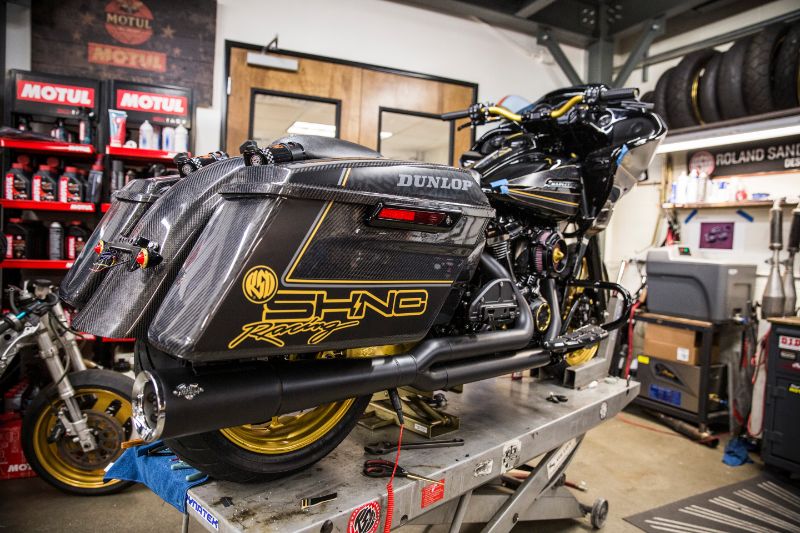 Photo: Joseph Hitzelberger
Photo: Joseph Hitzelberger
Carbon fiber abounds on the Roland Sands entrant. The 2-into-1 exhaust moves peak power to the higher RPM range used when hauling the mail. Floorboards are raised to increase cornering clearance and provide better feedback than the vibration-absorbing rubber that comes from the factory. Photo: Joseph Hitzelberger.
And that is a huge part of the appeal of performance baggers. Going fast on something that wasn’t meant to go fast is a reward with few parallels. You can’t just buy speed on the dealership floor, and the aftermarket is littered with so many knock-off parts designed to look cool that you can’t exactly buy speed out of a catalog either. I expect that’s a big reason that Drag Specialties wants to do the King of the Baggers event at Laguna Seca; to prove you can find trustworthy go-fast parts in a catalog… their catalog.
This Isn’t The First Time
If you think bagger racing is an oddball idea, it is. So was the Harley 883 class back in the late-1990’s. No one thought it would be fun to watch a herd of slow street bikes wobble down the racetrack. To the contrary, the series was a hit and even helped launch the career of upstart racers like the Bostrom brothers and Aaron Yates, with Ben Bostrom eventually heading to Europe and racing at the world level.
People also cried foul when the XR1200 class came along, requiring all the bikes to be fitted with the exact same performance kit from series sponsor Vance and Hines. The bikes were visibly unstable and had to be ridden with reckless abandon to make them go fast, but there were always a few dozen people on the grid willing to try. The XR1200 series even managed to race at the Indianapolis Speedway when the MotoGP series was there. The Harley’s easily put on the best show of the day, with a freight train of about ten bikes hammering each other from start to finish, and another twenty-or-so bikes having similar battles behind them.
Haters Gonna Hate
Most of the arguments against the King of the Baggers event evoke something called “the fallacy of ‘should.’” Simply, it means that when you say, “it should be like this,” you are turning an opinion into a fact. Yes, racing “should” be about the top riders on the top machines, battling it out at the top tracks with the top crews supporting them. But racing isn’t like that.
Racing is people deciding to take on something dangerous, difficult, and expensive. You shouldn’t risk your life to go around in a circle as fast as possible on any motorcycle, but who cares? People who want to do it—who are compelled to do it—are the outliers of society that we gladly watch on any Sunday, on any track, any time we can. We cheer the underdog who races with no funding or on outdated equipment or with their spouse as their only crew member. So why don’t we want to cheer on an entire class of underdogs?
Again, the fallacy of should.
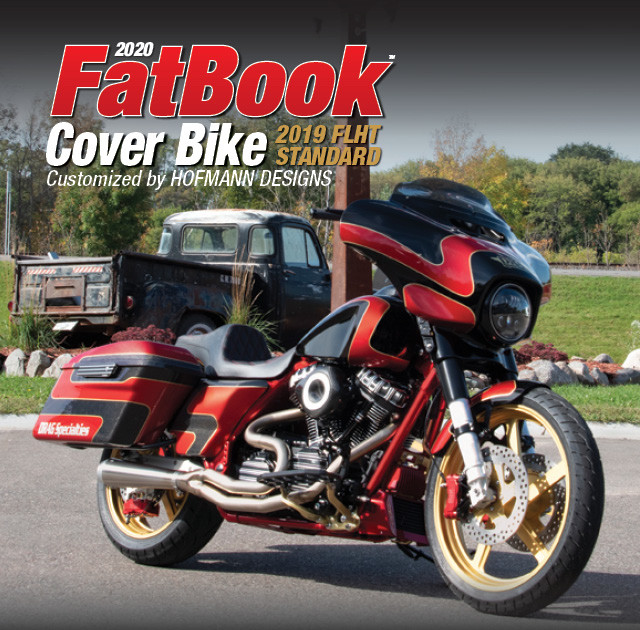 Photo courtesy of Drag Specialties
Photo courtesy of Drag Specialties
Performance baggers are big fun and big business. Drag Specialties has a huge selection of aftermarket upgrades for many types of machines in multiple catalogs. One of the cover bikes of these catalogs is this build by Hoffman Designs. Photo courtesy of Drag Specialties.
But even people who aren’t haters or snobs are struggling to wrap their head around racing an 800lbs touring bike around a racetrack. Even on MotoAmerica’s own podcast there was a bit of snobbery and false equivalence. Comparing this event to trying to stuff as many clowns as possible into a tiny car shows how far off-base some peoples’ concept of racing is.
I personally ran into this for over a decade when I raced sidecars. Despite racing a purpose-built, hand-crafted race bike at 150mph and setting records at the Pikes Peak Hill Climb, I still ran into racers who thought sidecars were some sort of joke. They called it “the sidecar sideshow.” Haters gonna hate…
It’s Going To Be A Helluva Show
Race fans, bagger owners, and haters alike are all going to line the fence on race day: that’s a fact. The main reason is that no one knows what to expect. Instead of the same 20-some-odd, near-identical machines running inch-perfect for 25 laps, we are going to see what custom builders really know about making a buffalo behave like a thoroughbred racehorse.
That makes it a chance for aftermarket companies to show off what they can do. People who follow Superbike Racing are already familiar with names like Yoshimura or Graves, who make go-fast parts for bikes already designed to go fast. But in the world of baggers, there are dozens of names the road-racing crowd have never heard of, making for some great stories. Custom builders like Roland Sands might have an edge in making high performance cruisers, but companies like MJK Performance and SLYFOX are eager to show a new crowd what they’ve been up to.
And the custom builders have to deal with much bigger brands like Barnett Engineering and Vance & Hines, who both have been involved in racing at drag strips, flat tracks, and road courses for decades.
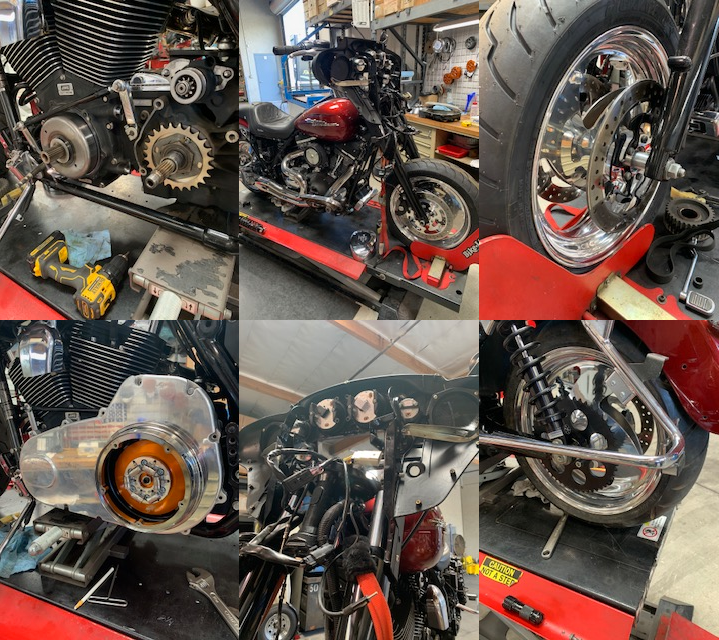 Photo courtesy Barnett
Photo courtesy Barnett
These aren’t stock baggers with flashy paint and wheels. Just look at these in-progress pictures of the build by Barnett. Their Scorpion lock up clutch is mated to a Jim’sUSA 131ci engine, the handlebar-mounted fairing is being gutted to lighten weight, and spun aluminum wheels will make the bike turn and accelerate quicker. Photo courtesy Barnett.
I’m not sure why so many people fail to grasp that companies with that kind of engineering ability aren’t planning to show up with flashy paint on a stock bagger and call it a race bike. My only guess is that the sportbike crowd simply refuses to see anything other than a sportbike as a performance machine. It has to look like a race bike in order to be a race bike. That’s the fallacy of ‘should’ in full effect.
A race bike is a race bike because you are racing it.
So this July 10-12 let the sparks fly and the brake rotors glow a bright red as over a dozen lunatics power down the world famous Corkscrew, the roar of their engines drowning out all the haters and naysayers who are watching from the sidelines instead of being on the track, putting on one helluva show.
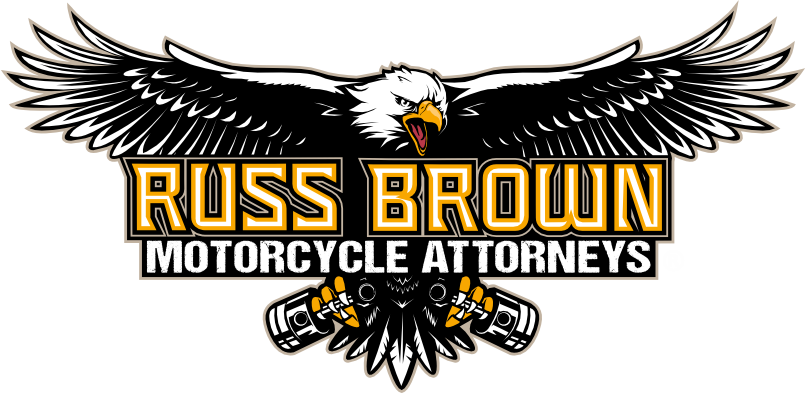
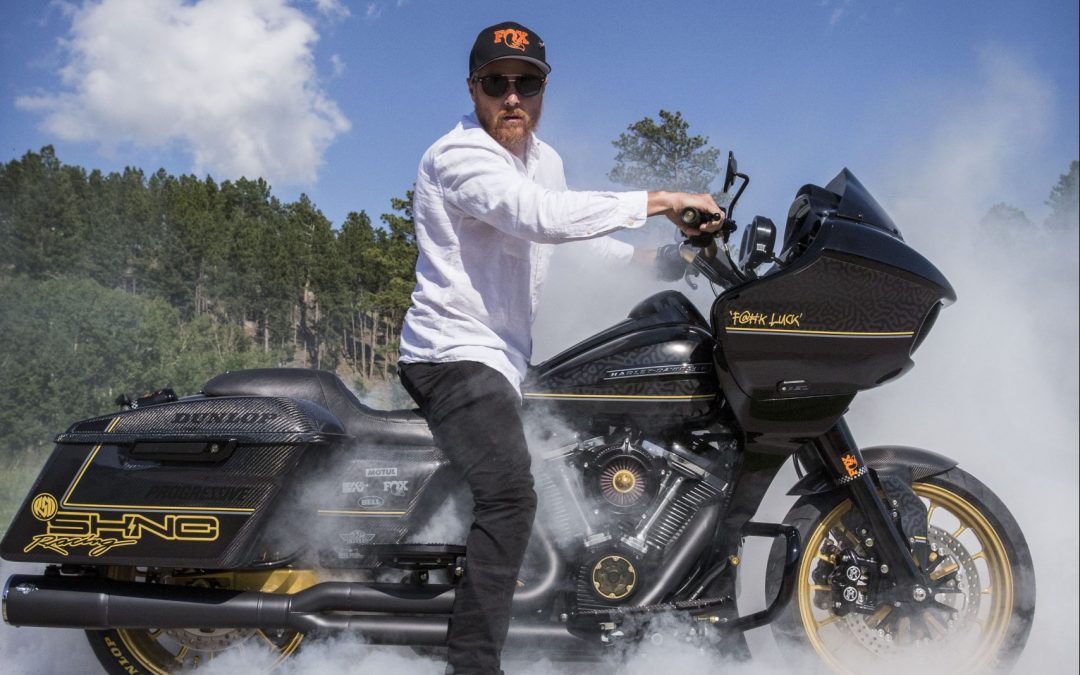
 Photo: Joseph Hitzelberger
Photo: Joseph Hitzelberger









